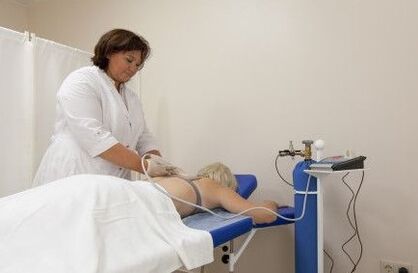Osteochondrosis of the cervical spine is a fairly common disease, against which dystrophic changes occur in cartilaginous tissue, in discs between the vertebrae and bone basis in them. This pathology develops in many people who have reached the age of 30. Symptoms for cervical osteochondrosis are diverse, so it is quite difficult to diagnose the disease and choose the right treatment.

Factors provoking the appearance of the disease
Cervical osteochondrosis can develop under the influence of the following factors:
- excessive weight;
- sedentary work, inactivity;
- previous injuries of the spinal column;
- mental disorders, nervous overstrain, stress;
- poor physical training;
- curvature of the spine, scoliosis, improper posture;
- the wrong position of the body, which has become a habit;
- tension in the neck, back during operation;
- inclination at the genetic level;
- unusual for the body of physical stress, increased activity;
- Inal meals.
The cervical region of the spine is subjected to increased loads, which the cervical muscles are trying to lead to equilibrium during the influence of the above sources. This provokes the appearance of muscle spasm, due to which there is a violation of the transportation of blood throughout the body. As a result, the formation of anatomical damage is noted.
Degree of osteochondrosis
In the process of developing cervical osteochondrosis, the disks between the vertebrae are weakened, due to which the structure in disks, vertebrae, articular fabric of the cervical region changes. The first degree disease proceeds almost asymptomatic, since the changes in the cartilage are just beginning. In this case, a person complains about the appearance:
- headache;
- discomfort in the neck, arms, shoulders;
- minor restrictions in the motor activity of the neck;
- short -term decrease in visual function;
- Reducing sensitivity in the collar zone.
The second stage is sometimes accompanied by the appearance of a small vertebral hernia, as well as narrowing of the cracks between the vertebrae. Due to infringement of nerve receptors, there is a feeling of point pain in the process of movements. Against the background of a second degree disease, the patient notes the appearance:
- pain syndrome in the neck, crunching with head movements;
- loss of sensitivity of the skin in the area of the arms and shoulders;
- reduction of visual function;
- ringing in the ears;
- numbness in the face and neck;
- weaknesses in the hands;
- shooting pains giving into the shoulder blade;
- Disorders in sleep functions.

It is very difficult to treat osteochondrosis of the cervical region of the third degree. At this time, a hernia develops, the spinal column is deformed, changes in position, dislocations in the elements of the ridge are noted. This stage of the disease is accompanied by:
- pronounced pain in the neck, myocardial, collar area;
- lack of skin sensitivity in the head, arms and shoulders;
- paralysis of the hands;
- lack of tendon reflexes;
- the formation of a hernia in the cervical vertebrae.
In the process of the fourth (final) stage, an exacerbation of signs is noted.
Symptoms
Signs of the disease in the neck are significantly different from the symptoms of osteochondrosis in another area of the vertebral column.Since the cervical vertebrae are located close, the nerve roots and spinal cord are pinched.This leads to the emergence of such signs:
- The pain syndrome is localized in the neck, nape, shoulders, arms and legs. At the time of joining the nervous receptors, the appearance of uncomfortable sensations in the shoulder zone, the back of the head, hands begin to be rebuilt. Due to spasm in the cervical muscles, blood circulation is disturbed.
- The occurrence of weakness in the upper extremities is noted, associated with damage to the functionality of the roots, which contribute to the inclusion of motor nerves that rebuild muscle tissue in the hands.
- The upper limbs are rebuilt due to a decrease in the sensitivity in them, violations of the roots in which sensitive nerve endings are located.
- When turning the head, painful sensations appear, you can also hear a crunch. This is explained by damage in the small joints of the cervical region, a decrease in the level of intervertebral discs.
- The patient complains of insufficient strength, the appearance of fatigue, dizziness, coordination disorders. Due to the displacement of the spine elements, the vertebral artery is squeezed. Because of this, blood circulation worsens, which leads to a weakening of blood supply to the occipital section and cerebellum.
- The appearance of problems with vision, loss of sensitivity in the language is noted.
Symptoms for cervical osteochondrosis in women are not different from signs in men. Women who have reached 45 years of age and older, who are diagnosed with such a disease, note numbness and tingling in the upper limbs in a dream.
What is the danger of osteochondrosis of the cervical region
The disease can harm the body as a whole. In the neck are located in a significant volume of arteries, nervous receptors, blood vessels through which the brain is supplied. If even a slight disease occurs, they are squeezed.This provokes the appearance of problems in the blood supply to the brain.As a result, the formation of migraines, heart rhythm disorders, the appearance of problems with the respiratory and visual function is noted, coordination and attention are also impaired.
Against the background of osteochondrosis of the neck, the formation of such diseases is possible:
- pathologies in the brain;
- arterial vessel syndrome in the spine;
- spinal stroke.
The most severe complication is the death of the patient, which can occur when squeezing the spinal canal. Symptoms and treatment of cervical osteochondrosis are due to the stage of the disease.
Therapeutic actions for cervical osteochondrosis
Therapy for osteochondrosis of the cervical spine is prescribed, regardless of the sexual gender of the patient. The treatment takes place in several stages:
- Removing painful manifestations.
- Elimination of swelling.
- Blood circulation to the norm.
- Fixing the muscles on the back, abdominal press, chest.
- Improving the quality of nutrition and regeneration of tissue spine.
If even insignificant signs of the disease are found, you need to consult a specialist. With such a pathology, an integrated approach is used, an inspection of a surgeon, neuropathologist, physiotherapist, and manual therapist is required.
For therapeutic purposes, against the background of cervical osteochondrosis, medicines, physiotherapeutic treatment, a massage of the collar zone, and physiotherapy exercises are used, since it is quite effective in this condition.
Medications
When detecting osteochondrosis of the neck, they are prescribed:
- preparations for eliminating muscle spasms;
- vitamin tools to improve metabolic processes in the central nervous system;
- medicines from the NSAID group to reduce pain, eliminate the inflammatory process and swelling;
- Joints for the joints, contributing to the restoration of cartilage, eliminate disorders in the disks between the vertebrae.
- Medicines that are favorable to improve the nutrition of affected nervous tissue, regulation of the transportation of blood flow into the brain.
First aid for exacerbation of cervical osteochondrosis
Sometimes, if the pain syndrome becomes unbearable, but it is not possible to visit a doctor, experts advise taking an analgesic. To facilitate pain, you can resort to the help of a "pepper patch", but this tool brings relief only for a short time.The patch will help warm up the affected area and relieve pain for a while.To get rid of the swelling, the use of herbal infusions is recommended for 3-4 days.
But it is worth considering that it will not work to recover from cervical osteochondrosis using such methods. These methods help to cope with the signs of the disease only for a short time. To prescribe full -fledged therapy, you will have to contact a specialist’s help.
Physiotherapeutic procedures
As part of a complex treatment, to improve the effect, use:
- Electrophoresis - the ions of an analgesic medicine is penetrated into the affected area due to the effect of electric current. During the procedure, novocaine or lidocaine is usually used.
- Laser therapy - it has an anti -inflammatory effect, improves blood circulation through the influence of light.
- Magnetic therapy - helps to get rid of edema in tissues, has an analgesic effect.
- Ultrasound - helps to improve metabolism, anesthesia, removes the inflammatory process in the affected area.

Medical physical education
Also, with cervical osteochondrosis, therapeutic exercises will help to improve well -being. It is worth noting that the performance of exercises should not be accompanied by pain or discomfort. Complex of exercises:
- We lie down on the stomach and rest on the floor. The back should be even, and the head and body are raised. We linger in this position for about 2 minutes, then we return to the starting position. We perform 2-3 repetitions.
- We sink to the floor, lay down on your back, out of your arms out along the body. We turn our heads first to the right then to the right, trying to touch the floor with the ear. We do the exercise 6-7 times in each direction.
- We sit on the floor. We take a breath and tilt your head forward in an attempt to touch the chest with it. On the exhale, we throw your head back. The exercise must be repeated 10-15 times.
- We sit on the floor, press our hands on the forehead and at the same time we lower your head. The exercise must be done for about 30 seconds, repeated 2-3 times.
- Smoothly, slowly, we rotate with our heads so as not to cause dizziness. In the case when the head began to dizzy, the exercise needs to be stopped. It is necessary to perform rotations 10 times left then to the right.
Home treatment
Such therapy can be used only as part of a comprehensive treatment prescribed by a doctor.At home, you can resort to the help of folk remedies, physiotherapy and massage.
With cervical osteochondrosis, you can use the following recipes:
- Put the horseradish sheet on a sludge and fixed with a bandage or fabric. The sheet must be poured with hot water, and then cool to room temperature. Such a bandage is placed before bedtime and left until the morning.
- Grate the potatoes and mix with honey in equal proportions. Apply to set up a compress every 7 days.
- To weaken pain, warming will help by means of mustard, a bag of sand, pepper patch, etc.

Before using all funds, it is recommended to seek a doctor’s consultation.
Massage
Healing massage can be carried out at home. You need to start massive a healthy area of the body, gradually moving to the affected area. The massage complex should be selected taking into account the individual characteristics of the patient, the degree of neglect of the disease. Massage should be carried out by the patient, placing it horizontally on the floor. You need to put your palms on your forehead, and my chin is protruding towards your chest. The muscles of the neck should be relaxed.
Massage is carried out as follows:
- First we massage the collar zone with stroking movements.
- Then go to squeezing. To do this, put your hands on the neck and move along the spine. Also, this technique can be used when massaging in the direction of the shoulders.
- To warm up the neck muscles, we rub it. This will help the body relax, improve blood circulation. You need to move from the skull along the spine using circular movements.
- The last movement is a vibration that is performed thanks to swaying and concussion.
Preventive actions
In order to prevent the development of cervical osteochondrosis, it is recommended:
- Sports (ideal option is to visit the pool).
- Enter products enriched with calcium and magnesium into the diet.
- Wash to several times during the day, especially when busy at a sitting work.
- In accordance with the requirements, to replace the pillow (purchase a low) and mattress (you need quite hard). Follow the neck of the neck in a dream: the neck should bend at least 15 degrees.
- Take a hot shower for at least 10 minutes throughout the day.
- People who do not welcome sports, doctors recommend periodically attending yoga section.
- Do not engage in simulators, as this can lead to a deterioration in well -being.

























































































